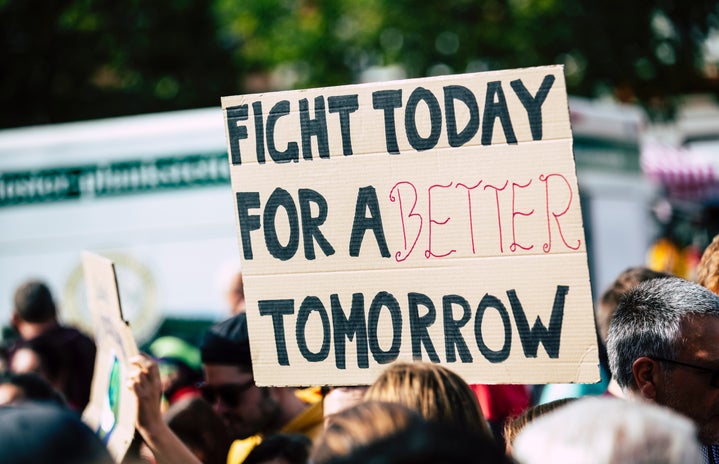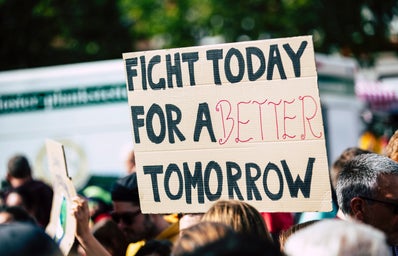Edited by Maham Qaiser
In the past month, the world has witnessed an unprecedented wave of protests in response to the War of Gaza. We see millions of people rallying in Washington D.C., London, and Indonesia, for example, demanding their governments vote for a ceasefire in Gaza. In retaliation, tens of thousands of pro-Israeli protestors flood the streets demanding that Israel maintain their position against Hamas and arguing against a ceasefire. With both sides heavily polarized, we’re also seeing both sides promoting the boycotts of particular companies for their political stances or involvement in the conflict. This collective activism on both sides of the conflict prompts a reflection on the historical effectiveness of protests and boycotts in achieving social and political change.
When have protests worked?
Protests are nothing new. They have at times served as the catalysts for change. One of the most iconic protests in history, is perhaps the Boston Tea Party in 1773, an American retaliation against British taxation that set the stage for the American Revolution and eventually independence. In modern history, the March for Our Lives Movement that emerged due to the tragic Parkland school shooting called for nationwide gun control reform. However, no protest holds more resonance to the ongoing conflict than the anti-Vietnam War protests in the 1960s and 1970s.
American disillusionment with the United States’ role in global conflicts was, in my opinion, a major contributor to America’s loss in Vietnam. Following the Second World War, America increased its operations in Vietnam fearing the spread of the communist agenda. The United States, which has appointed itself the protector of democracy, in response joined the conflict, and as the war continued they began bombing campaigns in Vietnam killing many civilians. At the same time, due to the time this war was happening, there was a rising anti-war sentiment in the U.S. because of America’s fight in WW2. People were also becoming worried by the massive loss of innocent civilian life in Vietnam. This is somewhat similar to the protests for Gaza, which challenge governments to stop their involvement in the War on Gaza. The Vietnam War protests, marked by impassioned youth activism and widespread public engagement, ultimately played a crucial role in shaping America’s policy decisions during the war. While the Vietnamese victory in the 1970s could be attributed to their strategies, I believe a large part of their victory came due to American disillusionment with America’s role in the war, and the protests from the Americans protests to bring troops back to the U.S.
When have protests not worked?
Despite the examples of protests that have worked. I believe there are many more examples of protests not having a significant effect. This is not to discourage protestors from protesting, but simply to offer some examples of when protesting has not been that effective. The Iraq War protests in 2003 are an excellent example of how large-scale demonstrations that, despite their global reach and impassioned pleas for peace, did not yield significant policy changes. In 2003, millions of people worldwide participated in protests against the impending invasion of Iraq, expressing their opposition to military intervention. Despite the unprecedented scale of these demonstrations and the widespread condemnation of the war, the invasion proceeded as planned, revealing a stark disparity between public sentiment and governmental actions. Similarly, during the Gulf War protests in the early 1990s, vehement objections to the U.S.-led intervention were voiced across the globe. However, these protests did not prevent the military operation from taking place. These instances underscore the efficacy of large protests. Sometimes despite public outcry, governments will act in ways that do not align with the expressed desires of their citizens. The Vietnam War protests remain a symbol of successful grassroots activism, but the Iraq War protests and Gulf War protests exemplify a disheartening reality where the collective voice of millions failed to alter the course of military interventions. These instances underscore the limitations of large protests, emphasizing that, at times, governments may proceed with policies despite widespread public opposition. The disconnect between public sentiment and governmental actions raises important questions about the responsiveness of political systems to the will of the people.
Ultimately, the effectiveness of protests is a multifaceted phenomenon. Protests have the power to raise awareness, shape public discourse, and contribute to social and policy changes. The efficacy of protests hinges on factors such as strategic planning, sustained effort, and government responsiveness. Clear goals, nonviolent tactics, and adaptability enhance their influence, but the ultimate impact can vary based on the political climate, socio-economic conditions, and the nature of the demands. Protests often extend beyond immediate policy changes, contributing to long-term shifts in societal attitudes and values. Overall, while protests remain a potent form of civic expression, their effectiveness is contingent on a complex interplay of factors that shape public sentiment and government response. Even if protests are unable to achieve governmental response immediately, they are effective in bringing causes to light.
Perceptions and Challenges of Protests:
It’s crucial to acknowledge that protests, while powerful expressions of dissent, can evoke mixed perceptions among the general public. Regardless of the cause, the disruptive nature of protests may inconvenience individuals not directly involved, leading to annoyance and potential opposition to the cause. I recognize that the aim of a protest is to capture the government’s attention, but there are occasions when this objective brings about unintended consequences.
It is incredibly important to uphold peaceful conduct during protests, as any instance of violence can severely harm the credibility of the movement. When protests escalate into violence, neutral observers are often discouraged, and those with opposing views may seize the opportunity to portray protestors as a threat, thereby undermining the legitimacy of the cause. Understanding the potential influence of public perception on the protest’s success emphasizes the significance of advocating peacefully to cultivate widespread support and prevent adversaries from exploiting the situation for negative purposes. We saw this happen with the Black Lives Matter protests, and even today.
Protests are important. That, to me, is undeniable. Protests can make a difference in the world. The Black Lives Matter Protests, the Vietnam War Protests, and the protests against the Iraq War, despite the extent of their efficacy in policy change, brought people’s attention to injustice.
When have Boycotts Worked
Boycotts have emerged as powerful tools in effecting consequential social and political change throughout history. The anti-apartheid movement in South Africa is a notable example of this. The international community’s widespread boycotts of South African goods, cultural exchanges, and sports events played a pivotal role in isolating the apartheid regime. The global outcry against the discriminatory policies led to economic pressure, diplomatic isolation, and heightened awareness of the systemic injustice. Notable initiatives, such as the cultural boycott endorsed by artists and entertainers, and the divestment campaign targeting companies with ties to South Africa, significantly contributed to the eventual dismantling of apartheid. Nelson Mandela himself acknowledged the impact of these boycotts, emphasizing their role in forcing the South African government to negotiate and ultimately dismantle the oppressive system. This historical precedent illustrates how targeted and coordinated boycotts, when supported on a global scale, can exert significant influence, not only economically but also in fostering international awareness and solidarity against injustice.
When have Boycotts not Worked?
Boycotts, as expressions of public dissent, have exhibited both successes and limitations over the course of history. The triumph of boycotts against apartheid-era South Africa illustrates their potential to leverage economic pressure and dismantle systemic injustice. However, there are also various examples of boycotts being inefficient, as seen in instances like the call to boycott the 2008 Beijing Olympics in protest of China’s human rights practices, which did not prevent the Games from proceeding. Similarly, efforts to boycott Chick-fil-A over its CEO’s stance on same-sex marriage and boycotts against Russian vodka in response to Russia’s invasion of Ukraine faced limitations. These cases underscore that boycott success depends on factors like widespread support, global economic context, and the nuanced relationship between consumer actions and policy change.
The effectiveness of boycotts varies based on diverse factors, including the nature of the cause, public support, and the responsiveness of targeted entities. While some boycotts achieve notable success in influencing policy changes, others encounter challenges in realizing their objectives. Boycotts can be potent tools for raising awareness, sparking public discourse, and pressuring entities to reconsider policies. The anti-apartheid movement’s use of boycotts, for instance, played a pivotal role in dismantling institutionalized racism in South Africa. Yet, the impact of boycotts is not guaranteed. Instances like calls for a boycott of the 2008 Beijing Olympics, despite widespread participation, did not bring about intended policy changes. Success often hinges on sustaining momentum, global coordination, and providing viable alternatives for consumers. Moreover, the effectiveness of boycotts is intertwined with public sentiment and the responsiveness of targeted entities. Some companies or governments may adapt their practices in response to public pressure, while others may resist or ignore calls for change.
Boycotts in today’s political climate
The current landscape of calls for boycotts in support of Palestinian liberation and human rights reveals an intriguing dynamic. Some protestors direct their efforts towards well-known companies, such as Starbucks and McDonald’s, due to perceived political stances. In fact, some of the companies currently being targeted by boycotters are beginning to feel the pressure. However, there’s a notable oversight as other companies actively work against the cause. The BDS Movement’s list provides valuable insights, suggesting a strategic approach to targeting companies for a more significant impact on the cause. For Canadian protestors, the Canadian BDS Coalition website offers a specific breakdown of how local companies may be complicit in Israel’s occupation of Gaza. While boycotts are potent tools for social change, a collective shift in focus toward companies playing more substantial roles in the conflict could enhance the efficacy of these advocacy efforts.
Similarly, pro–Israeli boycotters exist. The call for boycotting is at a much smaller scale here, but there is an increase in calls to boycott Starbucks as the Starbucks worker union shows support for Palestine. Huda Beauty is also a target of pro-Israeli protestors who disagree with the founder’s politics.
To conclude, the recent wave of global protests and boycotts in response to the War on Gaza underscores the complex dynamics of collective activism. While historical examples, such as the Boston Tea Party and the anti-Vietnam War protests, highlight the transformative power of protests, more recent instances like the Iraq War protests reveal the limitations of large-scale demonstrations in influencing policy changes. Similarly, the anti-apartheid movement in South Africa showcases the potential of boycotts to effect social and political change, yet challenges persist, as seen in unsuccessful attempts like the 2008 Beijing Olympics boycott. The effectiveness of both protests and boycotts depends on factors such as strategic planning, sustained effort, and the responsiveness of governments and entities. As the world grapples with contemporary conflicts, it becomes crucial to consider the nuanced landscape of activism, acknowledging that success often hinges on a multifaceted interplay of global coordination, public sentiment, and the specific nature of the cause at hand.


